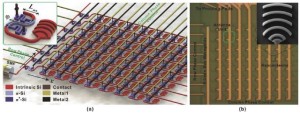By Dominic Siriani
The last full day of CLEO: 2013 has concluded, and it was a particularly intense day to say the least. Besides a full day of contributed talks, invited talks, and tutorials, the postdeadline session filled up the evening. With that, we’re now heading into the final, shortened day of the conference.
As has been the case throughout the week, I had the opportunity to catch a number of nice contributed talks. However, I also had the chance to attend a couple of hour-long tutorials. The first was on photonics with graphene, presented by Prof. Tony Heinz. Prof. Heinz gave an excellent overview of the many interesting mechanical, electronic, and optical properties of graphene. These properties include extreme robustness to mechanical stress, very high electron mobilities, and a uniform optical absorption distribution over a wide bandwidth of photon energies (and how this can be altered with doping). He not only described these phenomena but also gave an intuitive explanation of the physics behind them. Due to these interesting properties, graphene is being explored for making electro-absorption modulators, photodetectors, and flexible electrodes.
The second tutorial I attended was a description of the challenges in realizing ultraviolet nitride semiconductor lasers and how to overcome them. Dr. Noble Johnson provided a description of two paths to UV nitride lasers: the direct use of wide bandgap AlGaN and frequency doubling of InGaN-based devices. There are challenges to both approaches, but it appears that good progress is being made. In the AlGaN system, it seems that the primary difficulty is with achieving electrical pumping due to poor electrical conductivity at wider bandgaps (higher Al concentration), which causes impossibly high threshold current densities at short wavelengths. Dr. Johnson presented a number of novel approaches to overcome this issue. He also described the second approach to reaching UV, which is with frequency-doubled vertical external cavity surface emitting lasers (VECSELs). As compared to a vertical cavity surface emitting laser (VCSEL), VECSELs provide the opportunity to reach higher powers and incorporate in-cavity nonlinear materials due to the presence of an external cavity. By utilizing this approach, it’s possible to leverage the now fairly common blue laser diode technology to reach the ultraviolet regime.
 Nanoantenna array used for beamforming demonstrated by researchers at Massachusetts Institute of Technology (Sun et al., “Optical beamform engineering using phase and amplitude coded nanophotonic antenna arrays,” presented at CLEO postdeadline session, 2013).
Nanoantenna array used for beamforming demonstrated by researchers at Massachusetts Institute of Technology (Sun et al., “Optical beamform engineering using phase and amplitude coded nanophotonic antenna arrays,” presented at CLEO postdeadline session, 2013).
Finally, in the evening were the postdeadline talks. As usual, these were very high impact talks that represented some cutting-edge developments. As is the case for the entire conference, the postdeadlines consisted of talks representing fundamental physics, applied science research, and practical applications. These three areas covered a wide variety of topics, including imaging and spectroscopy, integrated photonics, plasmonics, quantum optics, and the list goes on. I wish I had space enough to go through all the ones I got the chance to see, but for the sake of anyone reading this I’ll only mention the first one I saw as a teaser (if you didn’t have a chance attend the session, be sure to check out the abstracts and other materials that should be available online). This was work by Sun et al. from the Massachusetts Institute of Technology on beamforming using a photonic antenna array with tailored amplitude and phase profile. As the talk motivated, it is necessary to control both amplitude and phase in the near-field in order to form any arbitrary beam in the far-field. To this end, the group made a nanophotonic antenna array with an amplitude distribution determined by varying directional coupler lengths and phase that can be dynamically tuned with integrated thermal-optic tuners. The main result was the ability to produce a Gaussian-shaped far-field capable of being dynamically steered in two-dimensions.
Well, that closes my likely final blog entry of CLEO: 2013. It was a great meeting as usual, and I hope everyone enjoys the final partial day of the conference!
Disclaimer: Opinions, interpretations, conclusions, and recommendations are those of the author and are not necessarily endorsed by the United States Government and MIT Lincoln Laboratory.
Posted: 14 June 2013 by
Dominic Siriani
| with 0 comments